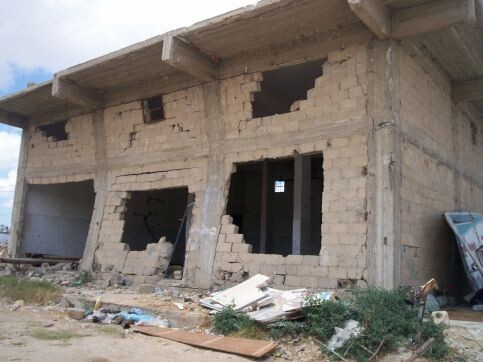The Electronic Intifada 23 August 2010

A bombed out biscuit factory in Gaza. (Mel Frykberg/IPS)
GAZA CITY, occupied Gaza Strip (IPS) - Just off Omar al-Mukhtar Street, Gaza City’s main thoroughfare, in a narrow, sandy alleyway is a little second-hand clothing shop. In the dimly lit store, with only intermittent electricity for some hours a day at best, sits a single battered and aging sewing machine.
This is where Khaled Nassan, a father of four children, tries in vain to eke out a living repairing and selling second-hand clothing. Nassan charges the equivalent of 25 cents on average to repair an item. Gazans can’t afford to pay the dollar it used to cost. Nassan is lucky if he takes home $20 a day.
“There is almost no business. I’m surviving on about $500 a month, and I have several children at university. My family is dependent on aid from the [UN agency for Palestine refugees (UNRWA)]. Without them we would not survive,” Nassan tells IPS.
Prior to Israel’s systematic strangulation of the coastal territory (which began during the outbreak of the second Palestinian Intifada or uprising in 2000 but peaked with its hermetic sealing in 2007 when Hamas took over) Nassan had a clothing factory which employed 250 Gazans who in turn supported nearly 3,000 dependents.
“I used to travel to Israel regularly for business to meet my Israeli business partners and visit stores where my clothing was sold. I would also purchase material there to bring back to Gaza but now I can’t import any material,” says Nassan.
“Previously my profits ranged around $20,000 monthly. I used to give my kids five dollars daily pocket money; now they are lucky if they get 50 cents. They have to walk long distances to and from university. We can’t even afford cheap shared taxis and I’m concerned about being able to fund their future education.”
Nassan is a harsh critic of the ruling Hamas regime. Eighty percent of Gaza’s population is now dependent on foreign aid, much of it from UNRWA. Despite Israel’s recent decision to ease the blockade it is still forbidding Gazan factories and companies from exporting their goods, and preventing the import of vital raw materials and spare parts and machinery.
Gaza’s economy was heavily dependent on the furniture, clothing, textile and food production sectors selling their goods outside Gaza.
Israeli authorities originally argued that the blockade on almost everything but bare humanitarian aid was for security reasons. However, following a lawsuit by the Israeli rights group Gisha the Israeli government was forced to acknowledge that the siege was a political move.
“A country has the right to decide that it chooses not to engage in economic relations or to give economic assistance to the other party to the conflict, or that it wishes to operate using ‘economic warfare,’” the government said.
Nassan is one of hundreds of formerly prosperous Gazan businessmen whose businesses and livelihoods have been decimated by the blockade and Israel’s devastating military assault on the strip during Israel’s invasion of Gaza at the end of 2008 beginning of 2009.
IPS visited the remains of a former three-story biscuit and potato chips factory belonging to Wael al-Wardah in northern Gaza a few hundred meters from the Israeli border.
The factory used to employ 150 individuals who supported approximately a thousand dependents. Its annual turnover was $10-12 million.
Craters, walls pockmarked with bullet holes, twisted and blackened machinery and equipment and sagging ceilings are all that remain after the Israelis employed F-16s, tank fire and bulldozers against the factory.
Al-Wardah, 43, father of seven from Gaza City, inherited the biscuits and potato chips factory from his father. His factory and the factories belonging to his four brothers who used to produce ice cream, sweets, potato chips and biscuits suffered 80 percent destruction and more than $10 million worth of damage during the Israeli bombardment. Twenty-two trucks and vehicles were also destroyed.
During the last three days of Israel’s 2008-09 winter assault, the Israeli Air Force embarked on an intensive bombing campaign aimed at the coastal territory’s economic infrastructure.
Israel had employed its “Dahiyeh doctrine,” which advocates disproportionate force in asymmetrical warfare against the civilian infrastructure of its enemies. Al-Wardah is adamant that no fighters were in the vicinity of the factories, because the Israelis were nearby.
Despite the bloody past, al-Wardah and his brothers are keen to start afresh. But they have been unable to import construction material to rebuild their factories. Al-Wardah is also unable to bring into Gaza machinery he bought in Europe.
“I have more than a million dollars of raw materials and specialist machinery sitting in Israel’s Ashdod port. It costs me $400 monthly to store the goods, but I still can’t bring them into Gaza,” he told IPS.
“Because I’m unable to continue my previous business I’m trying to start a pickled vegetable business, so I’ve brought in some equipment through the smuggling tunnels with Egypt. But this is very expensive and the tunnels get regularly bombed too.”
Karl Schembri from Oxfam in Gaza says easing the blockade doesn’t suffice.
“Gazans continue to suffer. The siege has to be completely lifted. There has to be free movement for people, and if the economy is to recover the import of raw material has to be allowed. Concrete and steel are needed to rebuild after the immense destruction,” Schembri told IPS.
All rights reserved, IPS — Inter Press Service (2010). Total or partial publication, retransmission or sale forbidden.





